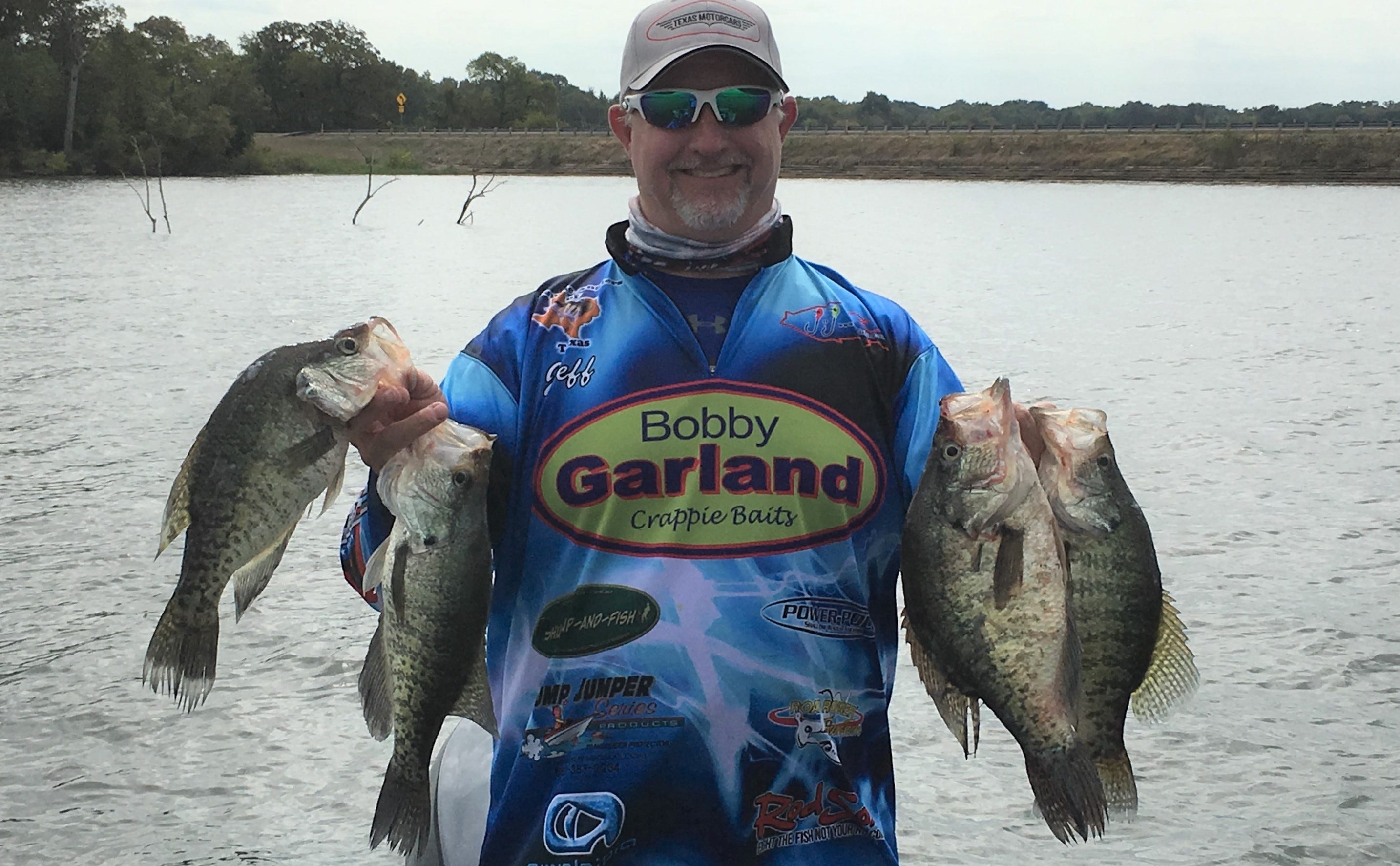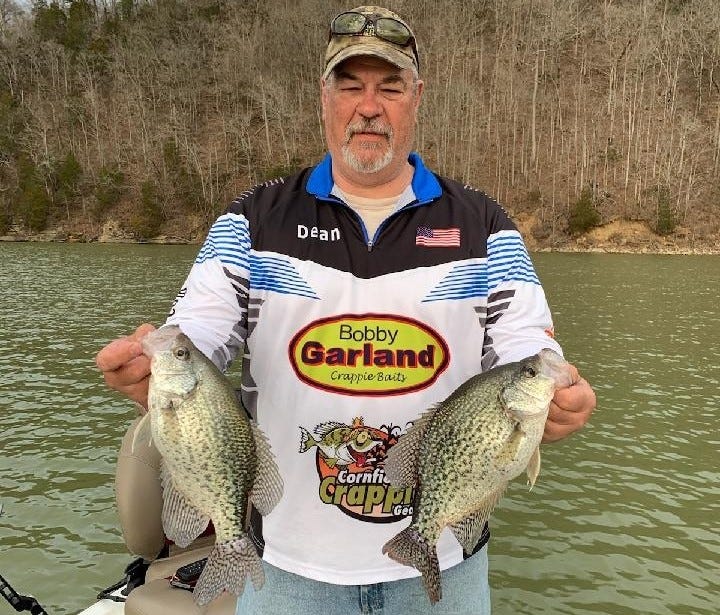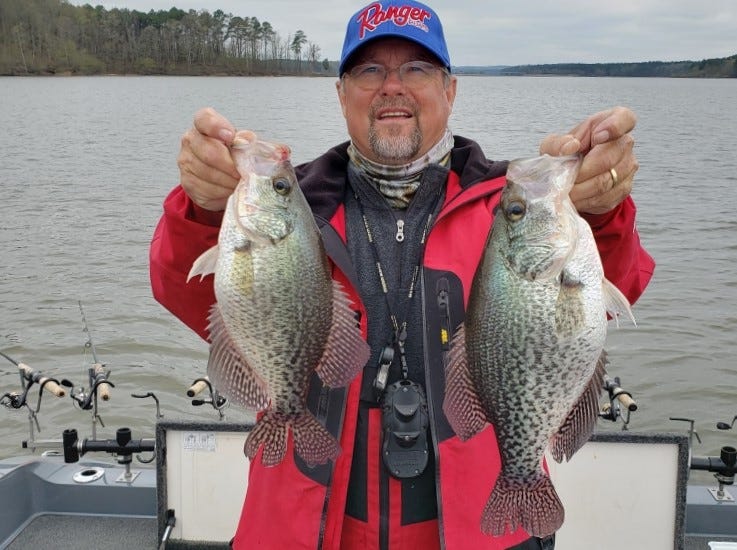- Nov 17, 2021
How to Fish Ledges for Fall Crappie
Ledges hold big concentrations of crappie this time of year. Learn how three veteran anglers find and catch crappie from ledges.
Crappie stay on the go in autumn, either looking for a quick meal during favorable conditions or seeking shelter, when the weather turns nasty. Some of the best places to find fall crappie that are moving are ledges, which are available in almost every lake in the country.
“A ledge in our part of the country is definitely a change in water depth, and most of the time, it is a pretty abrupt, pretty quick change,” said Freddie Sinclair, a full-time guide on North Carolina’s Jordan, Harris and Falls lakes. “Most of our ledges are hard bottom and rock.” Sinclair noted that a ledge could be a main channel drop along the old river channel or a creek channel drop in a cove or bay.
Texas angler Jeff Schwieterman defines a ledge as “a rapid change in depth – more of a vertical drop than slow slanting.” This crappie tournament veteran said depth changes of ledges can range from 1 foot up to 10 feet or more on the waters he frequently fishes.
Tournament competitor Dean McCoy has plenty of experience fishing ledges on Kentucky and Barkley lakes, where the bottom contour drops off from 8 to 10 feet deep, followed by a drop to 15 to 20 feet or as deep as 25 to 30 feet along the river channel.
“Some ledges are more vertical than others. Some have a small slope, and some have just a straight vertical ledge,” McCoy said. The main-lake ledges he fishes are rocky vertical edges, whereas the creek channel ledges he targets in the bays are more sloping with some rock mixed with mud due to siltation.
Crappie congregate along ledges in the fall because the structure is a quick route to food or shelter. “A ledge gives the crappie access to deep water and shallow water at the same time,” Sinclair said. “On any particular day if that fish decides to go shallow in the fall it can go shallow pretty quick.”
Schwieterman said crappie on his home waters of Lake Lavon relate to the shad spawn in the fall and follow the shad migration along the ledges. The shorter hours of daylight and cooler nights of early fall create a quick cool down in water temperature, causing shad to move shallower on the ledges, and crappie follow the baitfish. As the water temperature continues to drop throughout the fall, the shad and crappie move to deeper water along the ledges that offer a quick and easy route down to the next comfortable level of water temperature.
Ledge Sweet Spots


Ledges can stretch for long distances so crappie pros rely on their mapping and sonar to find the sweet spots on ledges that attract the most fish.
“I like to find a ledge that time of year that has some brush on it or maybe a rock pile,” Sinclair said. “It can also be a channel bend in the middle of the ledge that has an ambush point for those crappie to sit in and ambush prey.” Other sweet spots Sinclair looks for in the fall are underwater points bumping into a ledge or channel ledges next to islands.
Schwieterman and McCoy favor rocky ledges stair-stepping down into shelves at various depths. “You have more of a chance of finding those fish staged at those different ledges,” McCoy said.
Baitfish and weather determine the location of crappie along ledges during fall. McCoy said that most of the time crappie will hold tight to the ledge or suspend off the ledge over deep water, depending on where baitfish are congregating. He noted that another common sweet spot is any type of current break that creates an underwater eddy along the shelf.
“Crappie can change depths from day to day,” Sinclair said. “The fish can be at the bottom of the ledge or running bait up. If the weather is nice they might be up in the water column roaming the ledge. If the weather turns bad, the ledges can pay off pretty good because crappie have that deep water access pretty quick.”
Going high or low on the ledges usually pays off for Schwieterman. “When I am fishing those ledges, crappie are generally going to relate either to the top part of the ledge or the bottom part of the ledge,” he said. He has noticed that high barometric pressure in the fall causes crappie to hold tight to cover or the bottoms of ledges.
Fall Progressions


Crappie move to different types of ledges from early to late fall, according to our three crappie experts.
Sinclair finds crappie on his home lakes moving to the shallow ledges (15 feet or less) in early autumn, but as the water cools down the fish move to the deeper ledges in the 22- to 24-foot range. He has found that crappie will stay on deep ledges with access to depths of 30 or 40 feet throughout winter.
Crappie on Schwieterman’s home lake stage on the 12- to 15-foot ledges in early fall and drop down to ledges 20 to 25 feet deep as the water temperature continues to cool. “When it gets really cold (by late fall or early winter) at some point they really shut down and are tough to get,” he said. “They get in the 30-foot range, and when they get that deep they are roaming.”
During early autumn, McCoy keys on creek channel ledges where crappie are migrating into the bays. He also checks out some main-lake ledges from early to mid-autumn and then concentrates strictly on main-lake ledges when the water turns cold by late fall.
Ledge Lures


The Bobby Garland Stroll’R and Baby Shad are Sinclair’s favorite lures for ledge fishing during fall. “If the fish want something that has a subtle action to it I will use the Baby Shad,” Sinclair said. “If they want something with more action to it then I will use the Stroll’R. He rigs either on a 1/32-ounce jighead for finicky fish but will upsize to a 1/8-ounce jig for aggressive fish.
Water clarity and barometric pressure determine which lure colors Sinclair chooses. He favors black, pearl, chartreuse dominant colors for murky to muddy water and orange, chartreuse, silver or Blue Ice for stained to clear water. “If the barometric pressure is rising or high I tend to like something with red in it,” he said.
Sinclair trolls his lures at a speed of .3 to .8 miles per hour or vertical jigs the baits while watching his Garmin Panoptix LiveScope. He will also cast to the ledges and swim the lure across brush or rocks for aggressive fish.
When Schwieterman finds crappie on the bottom of a ledge he tempts them with a dual jig setup and fishes with a pole in each hand. His rig consists of a 1/8- or 1/16-ounce jig and Monkey Milk or Bone White/Chartreuse Baby Shad or Silverfish Minnow Mind’R set 18 to 24 inches above a 3/16-ounce pink jig and 3-inch Bobby Garland Slab Slay’R.
“I drop that lower jig onto the bottom just for a second and then raise it up and hold it there for a little bit,” Schwieterman said. “Then with the wind or the trolling motor I am just kind of working my way down the bank, kind of like slow trolling down that ledge.”
Horizontal and vertical presentations produce ledge crappie for McCoy in the fall. When he is vertical jigging, McCoy fishes a single pole rigged with a Baby Shad, Minnow Mind’R (tipped with a minnow) or a Bobby Garland Itty Bit Swim’R on the ledges. The Bobby Garland 2-inch Hyper Grub is McCoy’s favorite lure to present horizontally along the ledges.
Most of the time he matches his Bobby Garland baits with a 1/16- or 1/8-ounce jighead but affixes the Itty Bit to a 1/48-ounce jig with a 1/8-ounce egg sinker set about 18- to 24-inches above the lure. He pegs the sinker with bobber stops set above and below the weight. “The sinker helps to get the bait down but you still have that action of the Itty Bit,” McCoy said. His favorite colors are Blue Ice and Monkey Milk for the Itty Bit Swim’R and Hyper Grub; and Cajun Cricket, Monkey Milk and Outlaw Special for the Baby Shad and Minnow Mind’R.
McCoy presents his baits by pitching the lure and letting it pendulum slowly down to the fish or vertical jigging straight over the crappie. When vertical fishing, McCoy has found that the fish shy away from a moving bait. “They don’t want you jigging the jig; they just want it sitting there,” he said.
McCoy casts the Hyper Grub to the ledges where he lets the lure fall to the fish he sees on his LiveScope. The lively tail action of the Hyper Grub usually triggers strikes as the lure falls or during McCoy’s retrieve.
Boat Positioning on Ledges
Crappie moving up and down on the ledges make boat positioning critical for good lure presentations.
- Freddie Sinclair positions his boat downwind of a ledge and works his “way up the ledge to keep from crossing over the top of the fish.”
- Jeff Schwieterman starts on the shallow end of stair-stepping ledges and gradually moves to deeper ledges in calm weather. He starts on deeper ledges and moves shallower on windy days.
- When casting for crappie along ledges, Dean McCoy positions his boat 25 to 40 feet off the structure to make a horizontal presentation.



